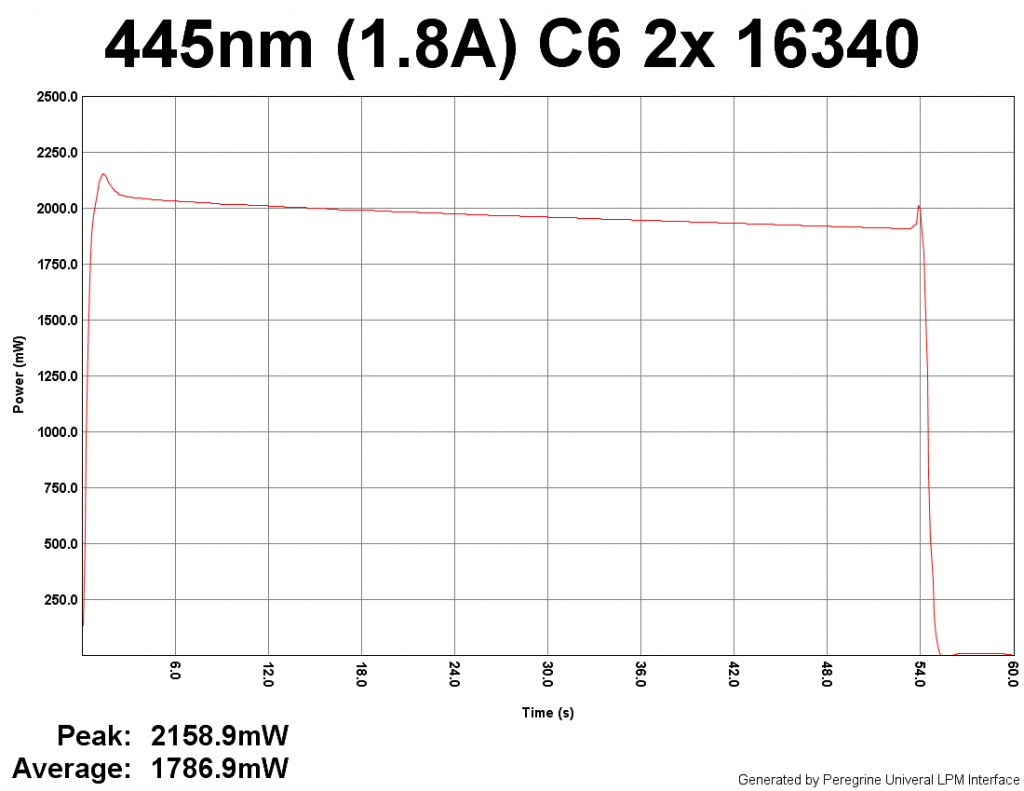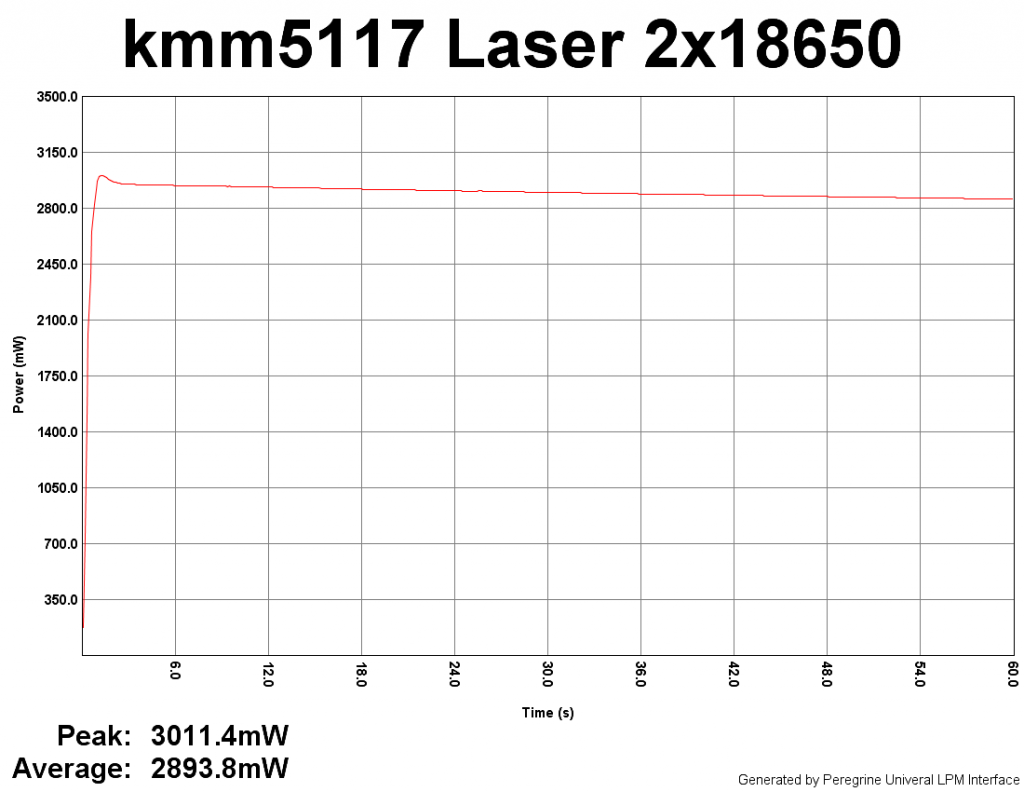- Joined
- Sep 20, 2008
- Messages
- 17,646
- Points
- 113
When I saw the detailed Review and posted power Graphs
of the Rubicon here...
http://laserpointerforums.com/f52/first-review-delta-rubicon-lpm-84268.html
I had noticed a few things that jumped out at me that didn't
look quite right but I had no time to investigate at that time.
In the past few days I took the time to have a look at it and
did some basic tests.
RINGING
If you look at the beginning of the graph you can see an
oscillation of the signal for ~4 seconds in one graph and
~6 seconds for the other graph before it stabilizes.
It is commonly known as ringing.
Notice also the maximum swing peak to peak is about
210mV (or mW) on one Graph and ~75mV on the other
Graph.
(For the sake of this Post and since we are using an OPHIR
20C head mV and mW are interchangeable)


If you compare that to the Graph supplied by BLORD of the
same Laser the beginning of the Graph does not seem to
exhibit the same ringing artifact.

I wondered if the ringing was actually coming from the OPHIR
heads and the fast sampling rate of the Rubicon was actually
picking up this previously unseen ringing.
I decided to hook a new pristine OPHIR 20C head powered by
two freshly charged 9V batteries to eliminate any possible PS
noise and see the output on our 100Mhz Digital Storage Oscilloscope.
This DSO can sample the input much faster than any hobbyist's LPM
firmware to date and should able to pick up any ringing artifcacts.
Here are some pics of what the scope showed... Remember that
these waveforms are raw output of the OPHIR head directly into
the DSO and have no additional filtering.
(DSO Full swing)

(DSO Overshoot)

Here is a shot with more detail...
(DSO Overshoot closeup)
The 1.5 second time is closer to actual.

It seems clear that a pristine OPHIR 20C head's output does NOT
produce this Ringing seen in the Rubicon Reviewer's Graphs...
OVERSHOOT
The other issue I noticed is the OPHIR heads output Overshoot...
In the Reviewer's 1.5W graph the overshoot is ~110mV with P-P swings
of about 210mV (or mW).
Blord's Graph shows an overshoot of only ~15mV and a single P-P
swing of ~15mV (or mW).
It should be noted that the higher the Laser Power tested with an
OPHIR 20C head the higher the overshoot will be.
RESOLUTION/JITTER
The last issue is the jittering of the signal over a long period shown
here.


It looks like the jittering is ~1-2mW on the 1.5W graph....
I find it strange that an LPM with a claimed 0.1mW resolution has jitter
that is at least 10 times higher than the resolution.
Perhaps what is causing the ringing is also causing the jitter...
CONCLUSION
From the previously posted data and my own DSO tests it seems
clear that
Blord's graph is much closer to the actual DSO readings...
It is evidently clear to me that there are some major issues with the Rubicon
LPM that need to be addressed and/or fixed before it is ready for the
consumer.
The problem could lie in one or more of the following...
1) the Lasers now exhibit a ringing output since Blord's Graph
1) the OPHIR head is defective or not adjusted properly
2) the Rubicon input electronics is producing the artifacts
3) the Rubicon Firmware is producing the artifacts
4) the Peregrine Software is producing the artifacts
It is important to state that I am only going by what was posted and can only
assume the data is correct since the sellers did not comment on the Graphs
artifacts in the Review thread.
It is also to be noted that at this time I don't have a Rubicon to do any real
time tests or to find out exactly where the problem with the Rubicon lies nor
do I care to help to troubleshoot it's apparent issues in light of the last month's
childish antics by the sellers.
Since I don't have a Rubicon to test (at the moment) I can't verify/test if the
above issues also cause problems with accuracy. So for now we'll assume the
power readings are accurate.
Jerry
of the Rubicon here...
http://laserpointerforums.com/f52/first-review-delta-rubicon-lpm-84268.html
I had noticed a few things that jumped out at me that didn't
look quite right but I had no time to investigate at that time.
In the past few days I took the time to have a look at it and
did some basic tests.
RINGING
If you look at the beginning of the graph you can see an
oscillation of the signal for ~4 seconds in one graph and
~6 seconds for the other graph before it stabilizes.
It is commonly known as ringing.
Notice also the maximum swing peak to peak is about
210mV (or mW) on one Graph and ~75mV on the other
Graph.
(For the sake of this Post and since we are using an OPHIR
20C head mV and mW are interchangeable)


If you compare that to the Graph supplied by BLORD of the
same Laser the beginning of the Graph does not seem to
exhibit the same ringing artifact.

I wondered if the ringing was actually coming from the OPHIR
heads and the fast sampling rate of the Rubicon was actually
picking up this previously unseen ringing.
I decided to hook a new pristine OPHIR 20C head powered by
two freshly charged 9V batteries to eliminate any possible PS
noise and see the output on our 100Mhz Digital Storage Oscilloscope.
This DSO can sample the input much faster than any hobbyist's LPM
firmware to date and should able to pick up any ringing artifcacts.
Here are some pics of what the scope showed... Remember that
these waveforms are raw output of the OPHIR head directly into
the DSO and have no additional filtering.
(DSO Full swing)

(DSO Overshoot)

Here is a shot with more detail...
(DSO Overshoot closeup)
The 1.5 second time is closer to actual.

It seems clear that a pristine OPHIR 20C head's output does NOT
produce this Ringing seen in the Rubicon Reviewer's Graphs...
OVERSHOOT
The other issue I noticed is the OPHIR heads output Overshoot...
In the Reviewer's 1.5W graph the overshoot is ~110mV with P-P swings
of about 210mV (or mW).
Blord's Graph shows an overshoot of only ~15mV and a single P-P
swing of ~15mV (or mW).
It should be noted that the higher the Laser Power tested with an
OPHIR 20C head the higher the overshoot will be.
RESOLUTION/JITTER
The last issue is the jittering of the signal over a long period shown
here.


It looks like the jittering is ~1-2mW on the 1.5W graph....
I find it strange that an LPM with a claimed 0.1mW resolution has jitter
that is at least 10 times higher than the resolution.
Perhaps what is causing the ringing is also causing the jitter...
CONCLUSION
From the previously posted data and my own DSO tests it seems
clear that
Blord's graph is much closer to the actual DSO readings...
It is evidently clear to me that there are some major issues with the Rubicon
LPM that need to be addressed and/or fixed before it is ready for the
consumer.
The problem could lie in one or more of the following...
1) the Lasers now exhibit a ringing output since Blord's Graph
1) the OPHIR head is defective or not adjusted properly
2) the Rubicon input electronics is producing the artifacts
3) the Rubicon Firmware is producing the artifacts
4) the Peregrine Software is producing the artifacts
It is important to state that I am only going by what was posted and can only
assume the data is correct since the sellers did not comment on the Graphs
artifacts in the Review thread.
It is also to be noted that at this time I don't have a Rubicon to do any real
time tests or to find out exactly where the problem with the Rubicon lies nor
do I care to help to troubleshoot it's apparent issues in light of the last month's
childish antics by the sellers.
Since I don't have a Rubicon to test (at the moment) I can't verify/test if the
above issues also cause problems with accuracy. So for now we'll assume the
power readings are accurate.
Jerry
Last edited:







